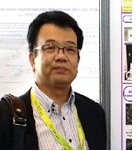Day 2 :
Keynote Forum
Mandip Singh
Florida A&M University, USA
Keynote: Nanoparticle constructs to overcome the barriers in lung cancer
Time : 10:00-10:30

Biography:
Mandip Singh completed his MSc and PhD in Biopharmaceutics from Dalhousie University, Canada respectively in1986 and 1989. He then worked with SynPhar Laboratories in Edmonton, Canada as a Group Leader, Drug Targeting from 1989-1993 and then moved to academia as an Assistant Professor, Pharmaceutics at Florida A&M University in 1993 and got promoted to Full Professor in 2002. Presently he is the Section Leader of Pharmaceutics at Florida A&M and has won many honors and awards such as Novapharm Award for the year 1989-1990 for excellence in Biopharmaceutics, AAPS Fellow award 2007, Davis Productivity Award from the State of Florida, 2009, 2011, 2015, Who’s Who in America 2008 and 2009, Research Excellence Award from FAMU, 2011. He was also selected as a Fulbright Fellow for the year 2014-2015. He has published more than 120 articles and papers in Biopharmaceutics and has five issued patents. He is a member for Controlled Release Society (CRS), American Association of Pharmaceutical Scientists (AAPS), American Association of Cancer Research (AACR), Society of Toxicology (SOT) and Society of Investigative Dermatology. Further he is the chair of the Dermatopharmaceutics Focus group at AAPS for the year 2014-2016
Abstract:
Lung cancer is the leading cause of deaths in the United States than any other disease. Non-small cell lung cancer (NSCLC) accounts for 85 percent of all lung cancers. Poor survival rates in NSCLC patients are due to limited efficiency of systemic or oral chemotherapy. Vascular endothelial growth factor (VEGF) over-expression is associated with poor survival. Recently, new approaches in the treatment of lung cancer with novel drugs that selectively inhibit tumor blood supply thus controlling cancer cell survival, proliferation and/or metastasis in combination with conventional anticancer or antiangiogenic drugs have generated clinical interest. DIM-C-pPhC6H5 (DIM-P), a c-substituted diindolylmethanes is novel anti-cancer agent. One of the objectives in my laboratory is to formulate tumor homing pegylated CREKA peptide coated nanolipid carriers of DIM-P and investigate its antitumor activity and antiangiogenic potential for treatment of lung cancer. Further, another objective in my laboratory is to overcome the stromal barriers for tumor penetration by using antifibrotic agents like Telmisartan in combination with nanoparticles. Our results have shown that agents like Telmisartan and Losartan play a significant role in enhancing tumor penetration by reducing collagen levels in tumors and also by inducing apoptosis.
Keynote Forum
Nobuhito Shibata
Doshisha Women’s College of Liberal Arts, Japan
Keynote: Polymer matrix supported drug delivery system: designing controlled-release formulations involving concept of nano-technology
Time : 10:30-11:00

Biography:
Nobuhito Shibata was born in 1962. After finishing a master course of clinical pharmacy at Kyoto Pharmaceutical University in 1986, He worked for Shiga University of Medical Science for 13 years as a hospital pharmacist. During this period, he got a PhD degree (Pharmaceutical Sciences) from Kyoto Pharmaceutical University. Subsequently, he changed his career and worked for Kyoto Pharmaceutical University for 6 years as an associate professor in the field of pharmacokinetics. In 2005, he was transferred to a higher post at Doshisha Women’s College of Liberal Arts as a professor of Faculty of Pharmaceutical Science. His research interests focus on the constructing drug delivery system using nano-particles.
Abstract:
Main purposes of drug delivery system (DDS) are improvement of drug absorption, controlled-release of drug and passive and/or active tissue targeting to maintain optimal drug levels in tissues. So called, all these concepts are for the sake of optimization of drug therapy. In regard to the controlled-release system, a large number of studies about it elsewhere in literatures, and numerous formulations have been provided by pharmaceutical industries on the market. On the other hand, progress in nano-technology has developed several ways to construct nano-device for DDS, and has enabled us to prepare DDS formulations which have more intelligent functions such as cancer or gene targeting. Nevertheless, as pharmaceutical additives, polymers which are derived from natural or artificial sources have important roles for designing DDS based on the nano-concept. In this keynote lecture, I’ll introduce my researches about construction of polymer matrix supported DDS, which are controlled-release systems, based on the nano-concept.
- Track 7: Medical Devices for Drug Delivery, Therapy and Surgery
Session Introduction
Joe Jensen
Noble, USA
Title: Device training and onboarding: Patient preference of smart training devices

Biography:
Joe is responsible for the global marketing communications at Noble. He began his career at Fortune Tech Data Corporation, managing the channel advertising for IBM touch screens and Fujitsu hard drives. With this knowledge, he became the Director of Marketing for Neo Media Technologies, responsible for their worldwide marketing strategies. Prior to joining Noble, Joe ran his own marketing consulting agency focused on strategic marketing planning and market segmentation for C-level executives. Joe has a BSBA in Marketing from the University of Florida, an MBA from Nova Southeastern University, and is an Adjunct Professor teaching Marketing for Managers at Lake Sumter State College.
Abstract:
For patients diagnosed with chronic medical conditions, daily self-administration using drug delivery devices, such as inhalers, MDIs and DPIs, is often necessary to successfully complete a treatment program. However, recent studies have shown that many patients are struggling to follow all the required steps outlined in the provided Instructions for Use (IFU) document.The lack of proper patient education around administering treatment, known as the onboarding, often results in misuse, user errors or discontinued use of a prescribed drug, costing the healthcare industry billions every year. According to a recent survey conducted by the University of Texas Medical Branch at Galveston (UTMB), 93 percent of patients use their inhaler incorrectly. Multisensory Training Devices are an example of recent improvements in technology that assist in creating an easier experience for patients to self-administer their medication. A user study conducted by Noble in Orlando, Fl. determined that 82 percent of users are most confident when training and onboarding with smart training devices that detect and teach them how to prevent errors. Additionally, smart training devices with error detecting technologies are preferred methods in overcoming anxiety and preventing errors. Participants will walk away with learnings for the next generation of self-administration in regards to error correcting trainers that decrease patient anxiety and increase sufficient completion of treatment programs.
- Track 1: Drug Delivery and Pharmacology
Location: Houston, USA
Session Introduction
Murtaza Tambuwala
University of Ulster, Northern Ireland.
Title: Colon targeted delivery of the hydroxylase inhibitor dimethyloxallogylcine (DMOG) provides enhanced protection in a murine model of colitis

Biography:
Dr. Murtaza Tambuwala is a Pharmacist, with a Masters in Pharmaceutical Technology from the School of Pharmacy and Pharmaceutical Sciences, Trinity College, Ireland. He earned a PhD in Translational Therapeutics at the School of Medicine and Medical Sciences, University College Dublin, Ireland in 2011 and has over 6 years of industrial formulation and drug delivery experience gained working with Sigmoid Pharma Ltd., Ireland. Dr. Tambuwala is currently a lecturer in Pharmacy at the School of Pharmacy and Pharmaceutical Sciences. His niche area of research is development of therapeutics for chronic inflammatory bowel diseases and bowel cancer. His research is published in highly reputed journals such as PNAS and Gastroenterology.
Abstract:
Pharmacologic hydroxylase inhibition represents a potentially important new therapeutic approach to colitis. However, because of potential side effects associated with systemic delivery of hydroxylase inhibitors including unwanted regulation of angiogenic, metabolic and erythropoeitic processes, it is desirable to develop new methods of delivery of such compounds to specific regions of the intestine in order to provide local therapeutic effects without systemic exposure. We have utilised an emulsion-based drug delivery system to attempt to achieve this goal. Initially, we demonstrated that the formulation of the hydroxylase inhibitor DMOG into a novel emulsion-based colon-specific delivery system was without effect upon the biological activity of the drug. The physical process of formulation of DMOG into the colon-specific drug delivery sphere system does not impact upon it’s biological activity. We next investigated the whether formulated DMOG is delivered specifically to the colon when the beads are administered orally to mice. This was investigated by using transgenic mice which ubiquitously express the firefly luciferase gene under the control of a concatomer of NF-kappaB response elements (NRE) to assess NF-kappaB activity in vivo. Our results demonstrate that colon-targeted DMOG delivery resulted in an effective and selective elevation in basal NF-kappaB activity in the colon. We next investigated whether the therapeutic efficacy of colon-specific DMOG delivery in a murine model of DSS-induced colitis. Results from these experiments suggest that colon targeted DMOG bead are protective against experimental colitis in mice at a 40 fold lower dose as compared to systemic administration of DMOG. Our previous work has demonstrated that a significant proportion of the protective effects of DMOG observed in models of intestinal inflammation is a result of enhanced intestinal epithelial barrier function which diminishes the exposure of the mucosal immune system to luminal antigenic material. We also investigated the impact of colon-targeted DMOG delivery on intestinal barrier function in mice exposed to DSS with and without DMOG along with an oral gavage of 4kD FITC labelled dextran. The colon-targeted DMOG provided an approximately equivalent degree of protection to intestinal epithelial barrier function while the non-colon targeted DMOG did not significantly decrease DSS-induced intestinal barrier dysfunction. In summary, these data demonstrate that formulation of hydroxylase inhibitors in a colontargeted manner allows a retention of therapeutic efficacy while significantly reducing systemic exposure and the potential for associated unwanted side effects.

Biography:
Dr. Ajaya Bhattarai is, at present, faculty member of Chemistry in the department of Chemistry , M.M.A.M.C., Tribhuvan University, Biratnagar, Nepal. He has received his M.Sc. degree from Tribhuvan University in 1998 and Ph.D. degree in Polymer Chemistry from North Bengal University, India in 2010. The title of his Ph.D. thesis is “Polyelectrolyte-Surfactant interaction in Mixed Solvent mediaâ€. He has been working in Tribhuvan University since 2002. Dr. Bhattarai has visited University of Warsaw, Poland for Post doctorate research in the area of Nanomaterials Physics & Chemistry as well as Surface Chemistry in 2012-2013.He had received support from University Grants Commission, Nepal for Ph.D. research and had also received Erasmus Mundus Scholarship for Post-doctorate research work from European Commission and Lund University, Sweden. Dr. Bhattarai has decorated by the International Award “Third World Academy Sciences for Young Scientist (TWAS)’’ Award for the year 2008 in Chemistry. He has also achieved Nepal Bidhya Bhusan Medal-KA in 2014 by the President of the Federal Republic of Nepal, Rt. Honorable Dr. Ram Baran Yadav. Dr. Bhattarai had presented his research findings in the field of Polymer Chemistry, Surface Chemistry, electrochemistry and Nanomaterials in several international and national conferences. He has published more than ten dozens of scientific research papers, articles, abstract books and also on published in different international repute as well as national journals. He has been supervising Master level students as well as Ph. D. students and working in several national and international projects. Presently he is acting as Editor of a peer review journal “ BIBECHANA†and Journal of Nepal Chemical Society. Recently, he has been honoured by American Chemical Society for Publication of peer-reviewed research and generosity in sharing the expertise.
Abstract:
In this paper precise measurements of Dynamic Light Scattering (DLS) of the effects of temperature, solvents (alcohols), water on the size and diffusion of CTAB reversed micelles in the thymidine/ CTAB/alcohol/ water system are reported. The concentrations of CTAB were varied from 0.051 to 0.28 mol/L. Thymidine concentration in during auto-correlation function registration was the same in each solvent 0.001 mol/L. Water concentration in the studied systems was defined by R parameter according to relation: R=[H2O]/[CTAB]. DLS measurements were done at 298.15 and 308.15K. DLS experiment involved on detection two relaxation modes (fast and slow) in the systems containing CTAB reversed micelles, water, thymidine and solvents (methanol and Butanol). The DLS data clearly show the solvent influence as well as thymidine presence on CTAB reversed micelles size and consequently their diffusion coefficients.

Biography:
Shinya Uchida, PhD, received his Ph.D. degree from University of Shizuoka in 1999. Dr. Uchida served as clinical pharmacist at University Hospital of Hamamatsu School of Medicine. He is associate professor at University of Shizuoka and his major interests include clinical pharmaceutical science, clinical pharmacology and pharmacokinetics. He has published more than 50 papers in reputed journals
Abstract:
About a half of patients with schizophrenia have poor medication adherence, resulting in recurrence of schizophrenia. Gummi drugs, shaped confectionary dosage forms, can be easily chewed and swallowed without water. Schizophrenic patients could easily take this formulation daily, improving medication adherence. Our goal was to develop gummi drugs containing aripiprazole (ARP) using commercially available ARP products (Abilify®; Otsuka Pharmaceutical Co., Ltd., Tokyo, Japan). Three ARP formulations (orally disintegrating tablets, ODTs; powder formulations; and oral solutions) were modified to gummy drugs (OD-G, PW-G, and OS-G, respectively). Furthermore, we prepared improved OD-G (ARP-G), which contained high ARP content. In terms of appearance, OD-G and ARP-G were transparent white, PW-G was shiny opaque white, and OS-G was chalky white with a rough surface. Pharmaceutical characteristics of ARP-G were demonstrated to be suitable for hospital formulations, and ARP-G could be stored for ≤1 month. We assumed patients taking gummi drugs will chew and divide them into several pieces. Therefore, the dissolution test was conducted with ARP-G divided into 2 to 8 pieces. As the number of divisions increased, the speed of dissolution also increased. The average dissolution rate of ARP-G divided into 8 pieces was similar to that of tablets and ODTs. There were no significant differences in Cmax and the AUC(0-24) between ARP-G and tablets after oral administration in Beagle dogs. In conclusion, we were able to develop ARP gummi drugs by using commercially available products as a hospital formulation. Because patients can easily take gummy drugs daily, ARP-G will help improve medication adherence .
Aly Nada
Kuwait University, Kuwait.
Title: Preparation and In-Vitro Evaluation of Meloxicam Co-Ground Mixtures

Biography:
Aly Nada is chairman of Department of Pharmaceutics, Faculty of Pharmacy, and Kuwait University. He has published more than fifteen papers in reputed journals.
Abstract:
Meloxicam is a non-steroidal anti-inflammatory drug of the oxicam class, used to relieve the symptoms of dental pain, arthritis, primary dysmenorrhea, fever and as an analgesic, especially where there is an inflammatory component. Meloxicam inhibits cyclooxygenase (COX) synthesis. This enzyme is responsible for converting arachidonic acid into prostaglandin H2. This is the first step in the synthesis of prostaglandins, which are mediators of inflammation. Meloxicam has been shown, especially at its low therapeutic dose, selectively to inhibit COX-2 over COX-1. The co-grinding technique, unlike the other solid dispersion techniques, was economically and environmentally desirable. In co-grinding approach, the use of toxic organic solvents could be easily avoided. Therefore, it was suitable for industrial manufacture on a large scale. Co-grinding of poorly water soluble drug (Meloxicam) particles with different hydrophilic polymers like PEG and / or PVP-K25 resulted in the formation of amorphous powders having enhanced drug solubility and dissolution properties , even if much smaller amount of hydrophilic polymers were used (MLX/hydrophilic polymers =1:1, w/w). According to percentage of drug dissolved, dissolution rate of MLX – PEG co-ground binary mixture prepared by ball mill or vibrational mill > MLX – PEG – PVP co-ground ternary mixture > MLX – PVP co-ground binary mixture > MLX – polymer physical mixture > MLX alone. As regards to the grinding techniques, co-ground mixtures prepared with ball mill has a relatively higher dissolution rate than those prepared with vibrational mill for all of the selected polymers at all of the employed ratios. An increase in the concentration of carrier in the co-ground blends resulted in an increase in the dissolution rate of MLX. The enhancement of dissolution of MLX from co-ground mixtures could be due to the reduction of crystalline nature of the drug in co-ground mixtures. Among all the prepared mixtures in this study, co-ground mixture of MLX and PEG in 1:4 ratio by ball mill showed the best results in terms of extent and rate of dissolution in water and phosphate buffer. This effect was not only due to particle size reduction, but also loss of crystalline nature of the drug during co-grinding. DSC and PXRD studies indicated that crystalline nature of drug was reduced after co-grinding with PEG and / or PVP as compared to their corresponding physical mixtures. SEM images showed that particle size of MLX was reduced after co-grinding with hydrophilic polymer PEG using ball mill.
Nicholas C Obitte
University of Nigeria, Nigeria.
Title: Acid stable Alginate micro capsules for the improvement of solubility and gastrointestinal stability of Artemether and Lumefantrine

Biography:
Nicholas C Obitte got his Ph.D in 2009 from the Department of Pharmaceutical Technology and Industrial Pharmacy, University of Nigeria, Nsukka. He is a senior Lecturer and has to his credit over 20 publications in International peer reviewed Journals. He is an Alexander von Humboldt postdoctoral Fellow.
Abstract:
Class II BCS drugs have dissolution and bioavailability challenges. Thus, lipid-based formulations have been explored to address them. Artemether and Lumefantrine investigated in this work are poorly soluble, requiring oral co-administration with oily foods to improve absorption. Oil or surfactant dispersions of these drugs may be prone to crystallization and acid hydrolysis (artemether) in the stomach. To prevent these unwanted events we encapsulated oil-surfactant solution of the drugs using an acid-stable wall-forming polymer. Considering the number of independent variables involved in the formulations, Full Factorial experimental design was employed to optimize their compositions. Therefore, the aims of the present study were to optimize excipient compositions and encapsulate (oil–surfactant solution of artemether and lumefantrine respectively with improved aqueous solubility and in vivo activity) in an acid-stable wall-forming calcium alginate capsules. A 33 Full Factorial experimental design was employed to optimize the compositions of the independent variables. The optimized batches were evaluated for quantity of oil encapsulated, percentage capsule yield, mean capsule diameter, percent loading efficiency, swelling index, in vitro drug release and in vivo antimalarial studies. Results showed that Alginate concentration most significantly (P < 0.05) contributed to variations in the parameters evaluated. Swelling index was higher in alkaline than acid pH. Less than 25% drug release was witnessed in SGF while up to 99 % release took place in SIF (pH 7.2). The optimized batches exhibited higher antimalarial activity compared to the commercial or pure drug samples. DSC revealed absence of drug crystallization. In conclusion, improved aqueous solubility and antimalarial activity of artemether and lumefantrine in acid-protective capsule membranes were achieved.
Mitra Mosharraf
HTD Biosystems Inc., USA
Title: Strategies to improve dissolution rate of lyophilized high dose protein formulations

Biography:
Dr. Mosharraf received her M. Sc. in Pharmacy and her Ph.D. in Pharmaceutical Sciences from Uppsala University. Prior to joining HTD Biosystems as the chief scientific officer, she held different positions at Pharmacia and Pfizer, where she was actively involved in the formulation development of protein drugs. She has several scientific publications in peer-reviewed journals in the areas of protein formulation, solubility and dissolution rate of sparingly soluble drugs and a patent on manufacturing crystals of growth hormone. She has also been an invited lecturer in Pharmaceutics at the Department of Pharmacy, Uppsala University on a regular basis.
Abstract:
There is an increasing interest in formulation development of lyophilized proteins and monoclonal antibodies at high concentration. Development of high dose protein formulations, is often associated with challenges such as slow dissolution of the lyophilized cake, poor syringeability, aggregation and thus poor stability after reconstitution. The latter becomes a major concern especially for the development of multi-dose formulations that may require several days of post-reconstitution stability, especially considering the protein preservative interactions. In this presentation the important parameters for improving dissolution of lyophilized protein cakes are discussed. Especial attention is paid towards dissolution of high dose protein formulations in dual chamber syringes, and strategies to improve dissolution rate of the lyophilized cakes in general.
Yuma Yamada
Hokkaido University, Japan.
Title: MITO-Porter, Mitochondrial drug delivery system toward innovative Therapy

Biography:
Yuma YAMADA is an Assistant Professor in the Faculty of Pharmaceutical Sciences, Hokkaido University and the Pharmacist in the Department of Pharmacy, Hokkaido University Hospital. He received B.S., M.S. and Ph.D. from Hokkaido University in 2003, 05 and 08, respectively. After an Instructor at Faculty of Pharmaceutical Sciences, Hokkaido University in 2007, he became an Assistant Professor in the Faculty of Pharmaceutical Sciences, Hokkaido University in 2009. He is Outstanding Reviewer of Journal of Controlled Release in 2013&2014.His main research interest is development of mitochondrial drug delivery system and nanoparticle packaging for various cargos (protein, nucleic acids, etc.).
Abstract:
A variety of human diseases, including neurodegenerative disorders, diabetes, cancer and inherited mitochondrial disease, are associated with mitochondrial dysfunction. Therefore, this organelle is a promising therapeutic drug target, and mitochondrial therapy would be expected to be useful and productive for the treatment of various diseases. To achieve such an innovative therapy, it will be necessary to deliver therapeutic agents into mitochondria in living cells. However, only a limited number of approaches are available for accomplishing this. We recently proposed a new concept of mitochondrial delivery, a MITO-Porter, a liposome-based carrier that introduces macromolecular cargos into mitochondria via membrane fusion (Y. Yamada et al, Biochim. Biophys. Acta 1778: 423-432 (2008)). Using the green fluorescence protein as a model macromolecule and confocal laser scanning microscopy as the detection methodology, we were able to confirm that the MITO-Porter is, in fact, capable of delivering a macromolecule to mitochondria. In this presentation, we will talk about our current efforts regarding validation of mitochondrial therapeutic strategy using the MITO-Porter system.

Biography:
Prashant S Khemairya has completed his PhD at the age of 29 Years. He is a Sr. Principal Scientist Formulation of Pharmaceutical/ Biotech Products at SRK Pharmaceuticals. He has developed more than 50 Pharmaceutical and Biotech products in just 6 years of industrial research journey. He is an award winner scientist. He has more than 15 international/ national research publications in reputed journals. He is having 10 patentable innovative products and their development techniques.
Abstract:
Breast cancer remains the utmost common invasive cancer and the second leading cause of cancer mortality for women in the United States. Worldwide, breast cancer comprises 22.9% of all cancers (excluding non-melanoma skin cancers) in the women. It is estimated that globally over 508000 women died in 2011 due to breast cancer (Global Health Estimates, WHO 2013). Liposomes are attractive due to their unique opportunities together with negligible side effects not only in cancer but also in the treatment of other diseases. In this study our aim is to develop combined prospective of Iron coated Liposomes (of Raloxifene Hydrochloride) and design a magnetic belt (magnetism < 0.1 T) for the management of breast cancer during earlier stages and prevention from developing invasive cancer, and osteoporosis in post-menopausal women. Keeping this objective, the present systematic study was focused to design magnetic belt in shape of women’s breast that will contain few magnetic fires having enough magnetism to attract Iron Coated Liposomes only during oral administration of Raloxifene hydrochloride, in order to overcome the poor bioavailability issue with the drug as well. Reloxifene or methanone, [6-hydroxy-2-(4-hydroxyphenyl)benzo[b]thien-3-yl]-[4-[2-(1-piperidinyl)ethoxy]phenyl]-, hydrochloride (a Selective Estrogen Receptor Modulator-SERM) is FDA approved drug and is used to decrease the chance of invasive breast cancer in postmenopausal women who have a high risk for developing the disease or who have osteoporosis. After oral administration of iron loaded liposomes, liposomes will distribute throughout the body through the systemic circulation and while magnetic belt will be on the cancer site (breast) resulting, accumulation of liposomes will be increase on the site because of Iron and magnet intersection. Ultimately drug concentration and absorption will also enhance on the surrounding areas of cancerous cells, hence cancerous cells will be denatured quickly.
- Track 9: Major challenges and Future Oppurtunities in Drug Delivery
Session Introduction
Michael O Rourke
Scotia Vision Consultants, USA
Title: The challenges and opportunities of sustained release ocular drug delivery technologies

Biography:
Michael O’Rourke had worked within the global drug delivery industry for more than 25 years including 3M Pharmaceuticals, Alza, Chiron Vison and Bausch & Lomb. His unique ocular drug delivery experience includes launching the world’s first intra-ocular drug delivery technology in Europe, Vitrasert®, and the world’s second, Retisert®, in the USA. He has managed 28 brands, led 13 product launches, structured/negotiated 12 strategic business deals and has been a Team Member in 18 device/drug approvals. He has both presented and published widely within ophthalmology at congresses and within respected journals.
Abstract:
The estimated number of people visually impaired in the world is 285 million, 39 million blind and 256 million having low vision. 65% of people visually impaired and 82% of all blind are 50 years and older. There have been major advances in recent years in developing and launching new sustained release ocular drug delivery systems. However, only a small number have achieved both global regulatory approval and commercial success. Despite the challenges, there remains a significant market opportunity to enhance current products or develop new technologies offering improved treatment options for patients suffering from the major blinding eye diseases. Four major blinding diseases, Age Related Macular Degeneration, Diabetic Retinopathy, Diabetic Macular Edema and Glaucoma, due to their whole or partial impact on the posterior segment of the eye, and their growing market sizes, may offer the most promising opportunities for future ocular drug delivery technologies. They affect large numbers of people and pose significant risk of vision loss and blindness for those affected. Current therapeutic options for these diseases may at best manage the condition, slowing or halting further deterioration or disease progression. New breakthrough treatments would benefit from robust sustained delivery of the drug to the target tissues in the posterior segment and, importantly, enhance compliance of patients with long-term treatment regimens for these chronic diseases, for example, avoiding or reducing the need for frequent injections. These drug-delivery challenges to the posterior segment of the eye, for both small and large molecules provide a significant market opportunity for the development of new therapies based on enhanced drug delivery methods and technologies. Topical eye drop application is still the most common method for treating anterior segment diseases, while intra-vitreal injections are used to manage posterior segment conditions. However, protective ocular barriers and clearing mechanisms necessitate frequent administration, decreasing patient compliance and increasing the risk for adverse effects. Developing novel controlled release systems to efficiently treat both anterior and posterior segment diseases offers great opportunities for new product development. This presentation will summarize important ocular barriers and pharmacokinetics to be considered and will discuss recent delivery approaches with a focus on clinical evaluation, regulatory hurdles, and current products in the pipeline.
Mircea Alexandru Mateescu
Université du Québec à Montréal, Canada
Title: Self-assembled starch excipients: From sustained release to chrono-delivery

Biography:
Mircea Alexandru Mateescu is a PhD from Bucharest Polytechnic University and receiver of a “Honorary Laurea†from Rome University “La Sapienzaâ€. He is a full Professor at UQAM since 1994. His research relates to Multifunctional Proteins and to Drug Targeting. He is the Co-inventor of more than 30 patents covering therapeutic enzymes and new excipients for drug delivery. He developed fruitful collaborations with pharmaceutical companies and was involved in several technological transfers. He published more than 130 papers in reputed journals, one book, and 8 book-chapters. He is the holder of Bombardier Prize (1999) for Technological Innovation, of Venezia Prize (Italian Chamber of Commerce, 2012), of Research-Career Prize (UQAM, 2014).
Abstract:
Starch and its derivatives, well known as natural hydrophilic polymers, swellable and gel forming materials, are largely present as excipient in various types of pharmaceutical formulations. More traditional uses consist in binding, compaction, disintegration or as film forming matter. In the last decades, studies at molecular level have shown how starch structure can be modulated to obtain specific matrix-forming properties and control the release of bioactive agents. The molecular self-assembly involves weak forces (hydrogen bonds, ionic interactions or van der Waals forces) between chains and is the driving element in the construction of new structures. The release profiles as well as the mechanical properties of these materials can be tailored specifically for their intended uses considering that, via self-assembling, minor alterations can greatly modify and improve the releasing properties. Derivatization operated to improve hydrophilicity and introduce ionic character on starch chains can give additional opportunities for its usage as a multi-tasking excipient. The continuous improvements of pharmaceutical formulations have been achieved by means of hydrogels, in particular environmentally sensitive hydrogels, considered as ‘smart’ delivery systems able to release the drug at the appropriate time and site in response to specific physiological triggers. The rich panoply of their structures and properties highly recommend the starch derivatives as excipients for drug sustained release or for chrono-delivery systems.

Biography:
Bernard Vrijens has developed ways of extracting clinical explanatory power from drug dosing histories, as patients variably comply with prescribed regimens in a series of scientific papers. He is building the largest repository of data, publications, and technical documents about electronically compiled dosing histories, in order to identify the most common dosing errors, particular dosing errors that can jeopardize efficacy, and optimal measurement-guided medication management to enhance adherence and maintain long-term persistence. He is the co-author of over 60 peer-reviewed scientific papers, and a founding member and managing director of the European Society for Patient Adherence, Compliance, and Persistence.
Abstract:
The development of new drugs is currently facing a challenging situation where for most therapeutic areas under investigation the therapeutic index is narrow. In this setting, it becomes essential to identify the optimal dose and dosing regimen that best balance safety and efficacy. This situation points to the need for adherence-informed clinical trials in which exposure to the test drugs is precisely measured to assess dose-dependent effectiveness. In a limited number of circumstances, the investigated drugs show an exceptionally high molecular potency or through a slow release delivery system they can be administered infrequently so that the responsibility for drug administration can be economically transferred to properly trained professionals. Those situations are, however, exceptional, so in most therapeutic situations the patients bear the responsibility for maintaining appropriate dosing in ambulatory care. Research on patient adherence shows that many patients cannot maintain dosing at therapeutically effective intervals. When interdose intervals are too long, drug concentrations in plasma decline; drug actions decline and eventually cease. Short interdose intervals result in concentrations of drug that exceed therapeutic limits and increase the risk of toxicity. Non-intrusive, reliable, and continuous assessment of patient adherence can be achieved by automatic compilation of drug dosing history data using electronic detection of entry into conventionally designed drug packages (“smart packagesâ€). The resulting dosing history data allow one to identify particular dosing errors than can jeopardize treatment outcomes, and can, in turn, be used to focus intervention to achieve full implementation of, and long-term persistence with, the dosing regimen.

Biography:
Pamela Davol is Project Manager of Clinical and Regulatory at Ximedica, LLC Her early research focused on therapeutic applications whereby antibodies or ligands that specifically bind to the receptors of cancer cells are linked to toxic drugs in order to deliver them directly into cancer cell has published more than fifteen papers in reputed journals.
Abstract:
The strategy of the Center for Devices and Radiological Health (CDRH) at FDA for usability validation of medical devices is aimed at the priority of evaluating device design as a means to reduce risks through mitigation of use-errors that may present serious harms to end-users and patients. In contrast, the strategy of the Center for Drug Evaluation and Research (CDER) is aimed at evaluating product packaging and labeling to ensure end-user comprehension of drug and delivery device instructions-for-use (IFU) and other labeling as a means to minimize risks for medication errors that may result in harm to the patient or ineffective drug treatment. Although both strategies align to a common purpose, each FDA Center’s requirement often presents a Catch-22. For example, the CDRH human factors testing requirementassumes that a pre-requisite for CDER’s testing for labeling is met before conducting a usability validation study (thus prompting of end-users to refer to product instructions is not allowed to re-create a real-life situation); however, CDER requirement for testing assumes that the device design-user interface evaluation has been completed so that a thorough evaluation of labeling comprehension can be acquired for all end-users tested (thus encouraging an evaluation whereby all end-users should be prompted to use the IFU during their use-scenarios) . This incongruence in approach often leads to strategies whereby the requirements of one center may be invalidated by the requirements of the other, thus presenting a significant challenge to companies aspiring to launch combination products consisting of both device and drug constituents, which must satisfy the HF testing requirements of both centers

Biography:
Mark Cresswell was awarded his PhD from Keele University in Synthetic Organic Chemistry, after completing a Masters in Medicinal Chemistry from University of Manchester. He is now a Senior Development Scientist for Lucideon, the international materials development and testing organization, and is focused on innovative new materials research for the healthcare sector. More specifically, he is responsible for developing novel inorganic-based drug delivery systems (iCRT) for the pharmaceutical industry.
Abstract:
Opioid medications are prone to abuse (either intentionally or accidentally) by patients, and cost the US healthcare system tens of billions of USD$ per year. FDA is putting increasing pressure on manufacturers to reduce the risk of misuse of these drugs by developing “abuse-deterrent formulationsâ€. This, ironically, is slowing the introduction of new, improved medications to patients in need, even though the intention is to improve the patients’ safety. Opioids are the most prominent class of addictive drugs, but other classes of drugs that may benefit from such technologies will also be discussed, for example amphetamines and benzodiazepines. Many of the currently available technologies either provide mechanical or chemical barriers to abuse, and some of the marketed technologies will be highlighted and critiqued. Inorganic controlled release carriers are receiving growing attention from pharmaceutical companies due to the ability to tightly control and manipulate the carrier microstructure and thus drug release rates. Lucideon has developed a proprietary platform (iCRT-deter) that exploits two inorganic materials and is ultimately also a new approach to providing abuse deterrent properties to oral formulations. The technology concept, a non-confidential scientific explanation of the effects and mechanism, and supporting pre-clinical data will be discussed. This event will be the first time much of this information and data has been released into the public domain and the first time Lucideon has ever presented on the technology at a conference.

Biography:
Shashi Ravi Suman Rudrangi is a Research Associate at the Medway Centre for Pharmaceutical Science, University of Greenwich, United Kingdom. He pursued his Bachelor’s degree in Pharmacy from Kakatiya University, India in 2008; his Masters and PhD degrees in Pharmaceutical Science at the University of Greenwich in 2010 and 2015, respectively. He works on the ‘Inclusion complexation of poorly soluble drugs with cyclodextrins’ using organic solvent-free supercritical carbon dioxide processing method. He is a Member of the Royal Society of Chemistry, UK; Member of the Academy of Pharmaceutical Sciences Great Britain, UK and a Life Member, Chemical Research Society of India. He is the current Chair of the Student Association of the Academy of Pharmaceutical Sciences, Great Britain.
Abstract:
The aim of this study was to enhance the apparent solubility and dissolution properties of flurbiprofen through inclusion complexation with cyclodextrins. Especially, the efficacy of supercritical fluid technology as a preparative technique for the manufacture of flurbiprofen-methyl-β-cyclodextrin inclusion complexes was evaluated. The complexes were prepared by supercritical carbon dioxide processing and were evaluated by solubility, differential scanning calorimetry, X-ray powder diffraction, scanning electron microscopy and in vitro dissolution studies. Computational molecular docking studies were conducted to study the possibility of molecular arrangement of inclusion complexes between flurbiprofen and methyl-β-cyclodextrin. The studies support the formation of stable molecular inclusion complexes between the drug and cyclodextrin in a 1:1 stoichiometry. The results obtained from different analytical studies suggest complete complexation or amorphisation of flurbiprofen and methyl-β-cyclodextrin binary samples prepared by supercritical carbon dioxide processing. In vitro dissolution studies showed that the dissolution properties of flurbiprofen were significantly enhanced by the binary mixtures prepared by supercritical carbon dioxide processing. The amount of flurbiprofen released from drug alone was very low with 1.11±0.09% dissolving at the end of 60 min while the binary mixtures processed by supercritical carbon dioxide at 45°C and 200 bar released 99.39±2.34% of the drug at the end of 30 min. The study demonstrated the single step, organic solvent-free supercritical carbon dioxide process as a promising approach for the preparation of inclusion complexes between flurbiprofen and methyl-β-cyclodextrin in solid state. The preliminary data suggests that the complexation of flurbiprofen with methyl-β-cyclodextrin will lead to better therapeutic efficacy.
- Track 5: New Horizons in Vaccine Drug Delivery
Session Introduction
Xinyuan Chen
Massachusetts General Hospital, USA
Title: Micro-fractional epidermal powder delivery for improved skin vaccination

Biography:
Xinyuan Chen has completed his PhD from Nanjing University and Postdoctoral studies from Massachusetts General Hospital/Harvard Medical School, USA. He is now Assistant Professor at University of Rhode Island, USA. He has published 17 papers in reputed journals and is a recipient of NIH Career Development Award.
Abstract:
Skin vaccination attracted much attention in the last two decades due to significantly improved vaccine immunogenicity as compared to conventional intramuscular vaccination. Yet, the technical difficulty and frequent local reactions hamper its broad application in the clinic. We developed a micro-fractional epidermal powder delivery (EPD) technology to facilitate skin vaccination and minimize local reactions. EPD is based on ablative fractional laser or microneedle treatment to generate microchannel (MC) arrays in the epidermis followed by topical application of powder drug/vaccine-coated array patches to deliver drug/vaccine into the skin. EPD could deliver more than 80% sulforhodamine b (SRB) and model antigen ovalbumin (OVA) into murine, swine, and human skin within 1 h. EPD of OVA induced a comparable anti- OVA antibody titer to intradermal (ID) injection and much higher anti-OVA antibody titer than tape stripping-based patch delivery. Strikingly, the micro-fractional delivery significantly reduced local side effects of LPS/CpG adjuvant and BCG vaccine and resulted in complete skin recovery. In contrast, ID injection induced severe local reactions that persisted for weeks without complete skin recovery. While reducing local reactogenicity, EPD of OVA/LPS/CpG and BCG vaccine induced a comparable humoral immune response to ID injection. EPD of vaccinia virus encoding OVA induced significantly higher and long-lasting interferon γ-secreting CD8+ T cellsthan ID injection. In conclusion, EPD represents a promising technology for needle-free, painless skin vaccination with reduced local reactogenicity and at least sustained immunogenicity.
- Track 2: Different Routes of Drug Administration
Session Introduction
Reenu Yadav
IES College of Pharmacy, India
Title: Development and characterization of in situ gel system for nasal delivery of levodopa

Biography:
Reenu Yadav is completing her Ph.D from IES College of Pharmacy; India She has published five papers in reputed journals.
Abstract:
The objective of the present study was to develop a thermo sensitive in situ gel system based on chitosan (CS) and poly vinyl alcohol (PVA) for nasal delivery of Levodopa. The hydrogel was prepared by mixing the chitosan and poly vinyl alcohol. The concentration of the components was optimized during formulation development. The prepared hydrogel was characterized for gelation temperature, gelation time, viscosity changes, degree of swelling, in vitro release and in vivo activity. The prepared hydrogel was liquid at room temperature while underwent thermal transition from solution below or at room temperature to non-flowing hydrogel when incubated at 37ºC within 12-15 minutes with increased viscosity. The in vitro release of levodopa from gel network was observed, the release of levodopa through gel network decreases upon increasing the chitosan concentration from 1 to 5%. Furthermore, the formulation when evaluated for their in vivo activity results indicates that the proposed thermo sensitive in situ gelling system has substantial potential as nasal delivery system for levodopa.
Flavia Laffleur
University of Innsbruck, Austria
Title: Hyaluronic acid as potential excipient for buccal delivery

Biography:
Flavia Laffleur is completing her Ph.D from University of Innsbruck at the Department of pharmaceutical technology. She has published two papers in reputed journals.
Abstract:
Summary: Biomaterials have gained immense interest in the pharmaceutical research in the last decades. Hyaluronic acid a carbohydrate and mucopolysaccharide was chemically modified in order to achieve and establish a promising platform for buccal drug delivery. Aim: Novel biomaterial was tested for its potential for buccal drug delivery. Background: Polysaccharide hyaluronic acid (HA) was chemically modified with cysteine ethyl ether (CYS). By immobilization of the thiol bearing ligand on the polymeric backbone the thiolated bioconjugate HA-CYS was obtained. Methodology: Mucoadhesive, permeation enhancing and stability potential as well as mechanical, physicochemical properties further mucoadhesive strength, swelling index and residence time were investigated. The developed thiolated bioconjugate displayed enhanced mucoadhesiveness on buccal mucosa as well as permeation behavior and polymer stability. The near neutral pH and negative cytotoxicity studies indicated their non-irritability and biocompatible nature with biological tissues. Further, the model drug sulforhodamine 101 was incorporated to determine its drug release profiles. Results: The synthesized thiomer showed no toxicity. The mucoadhesion of thiolated hyaluronic acid on buccal mucosa was significantly improved in comparison to unmodified one. The biomaterial showed 2.5-fold higher stability in polymer structure. The release of sulforhodamine in presence of thiolated hyaluronic acid was 2.3-fold increased compared to hyaluronic acid. Conclusion: Thus, the promising results encourage further investigations and exploitation of this versatile polysaccharide. So far, hyaluronic acid was not evaluated for buccal drug delivery.

